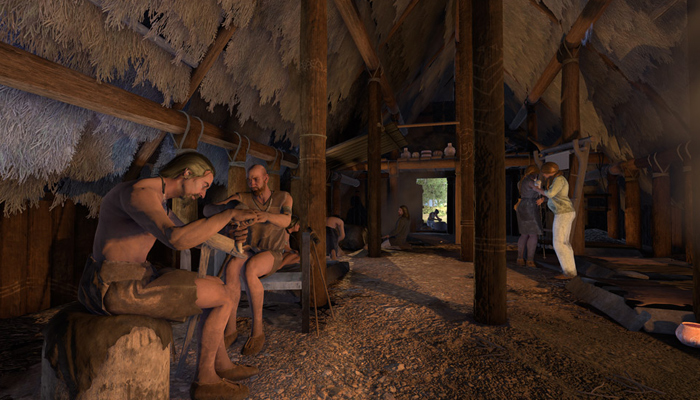- Client
- Badisches Landesmuseum Karlsruhe
- Content
- Virtual Reality for Museum Exhibition
- Related references
- Virtual Vianden Box
- Tags
With the newly opened exhibition “Archaeology in Baden”, the Badisches Landesmuseum in Karlsruhe is pursuing a revolutionary new museum concept. Selected objects illustrate the early cultural history of Baden from the Palaeolithic Age to the Carolingiansn, displayed at numerous modern and digitally “extended” stations.
First the visitor enters the “mystically” dark entrance room, in which 13 selected magnificent exhibits from different times can be admired. They are combined with digital screen information. The visitor continues into the brightly lit “Expothek”, which resembles a research laboratory – the objects there can be literally researched. You can further gather information with the help of “ExpoPhones” and Augmented Reality. Interactive media tables also offer plenty of space for in-depth research. Various “challenges” in terms of content and a playful examination of the collection objects from the large museum database await you there. In the same room, a newly developed 3D photogrammetry scanner controlled by a robotic arm allows the largely automated, high-resolution photorealistic scanning of objects from the exhibition.

In the subsequent “ExpoLab”, the visitors* dive into the past at a total of six Virtual Reality (VR) stations and experience the objects exhibited there in their original context. What the VR headset wearers* experience in an “all-round” perspective can be observed by other visitors* inside the ExpoLab on monitors. In this way, the “outsiders” are also integrated into the experience.
The immersive experience in the meticulously reconstructed worlds was conceived, modelled and programmed in an elaborate project lasting many months, carried by the archaeology and multimedia specialists* of ArcTron 3D. The VR glasses gradually make the real ExpoLab room disappear. Around the objects, a “whole world” emerges and rousing stories about the activities in a Neolithic nave beginn. Watch the production steps in a Bronze Age metal workshop or witness an Alemannic warrior being ambushed, followed by his later burial .
"People received the exhibition well, it was a very lively event - especially the virtual reality glasses were extremely popular."
Eckart Köhne, Director of the Badische Landesmuseum
The scenes aim to create their own aesthetics between realism and computer games (“serious gaming”), in which visitors can interactively follow the various “virtual” prehistoric activities. The movements of the people acting and interacting in the scenes were digitized using state-of-the-art motion capturing technologies and transferred to the virtual figures.
At first, you see a rather simple showcase filled only with ceramic fragments, which are actually exhibited in the ExpoLab. They come to life in VR. The fragments fly from the showcase towards the visitor and on to the longhouse, where the fragments “miraculously” fit into the complete vessels suspended there on a wooden beam.
Visitors are now standing in a scenery in a settlement of the oldest Neolithic period (Linear Pottery, 6th century BC). A narrator escorts you throughout your visit – here in particular to the typical longhouses. You can interactively select and observe varied activities of the inhabitants in a longhouse, such as thread spinning, weaving, attaching stone axes to their shafts, baking bread and more.

In a similar way you can follow the production process of a bronze axe in the Middle Bronze Age. In the ExpoLab showcase you will first encounter the casting moulds of some typical stone heel axes, which are then processed in the Bronze Age workshop to the final product.

The last VR station offers an almost “dramatic” scene: a richly equipped Alamanian equestrian warrior, who certainly belonged to the upper class of the time, is ambushed right in front of the visitors*. The warrior is struck down with an arrow. The burial scene to be observed afterwards is based on the archaeologically investigated case – the particularly rich grave findings from Hintschingen (district of Tuttlingen).




We are convinced that with these VR worlds exciting and innovative interaction and mediation strategies can serve archaeological museums alike. The applications are easy to navigate, e.g. only by gaze control waring the gaming headset, and thus used by visitors of any age. They are motivated to develop the various contents in the VR environment individually and interactively.
During the opening of the exhibition, we were particularly surprised by the length of stay at the individual stations. We were very happy to observe that not only the young audience but also many senior were intensely occupied with these new VR technologies.